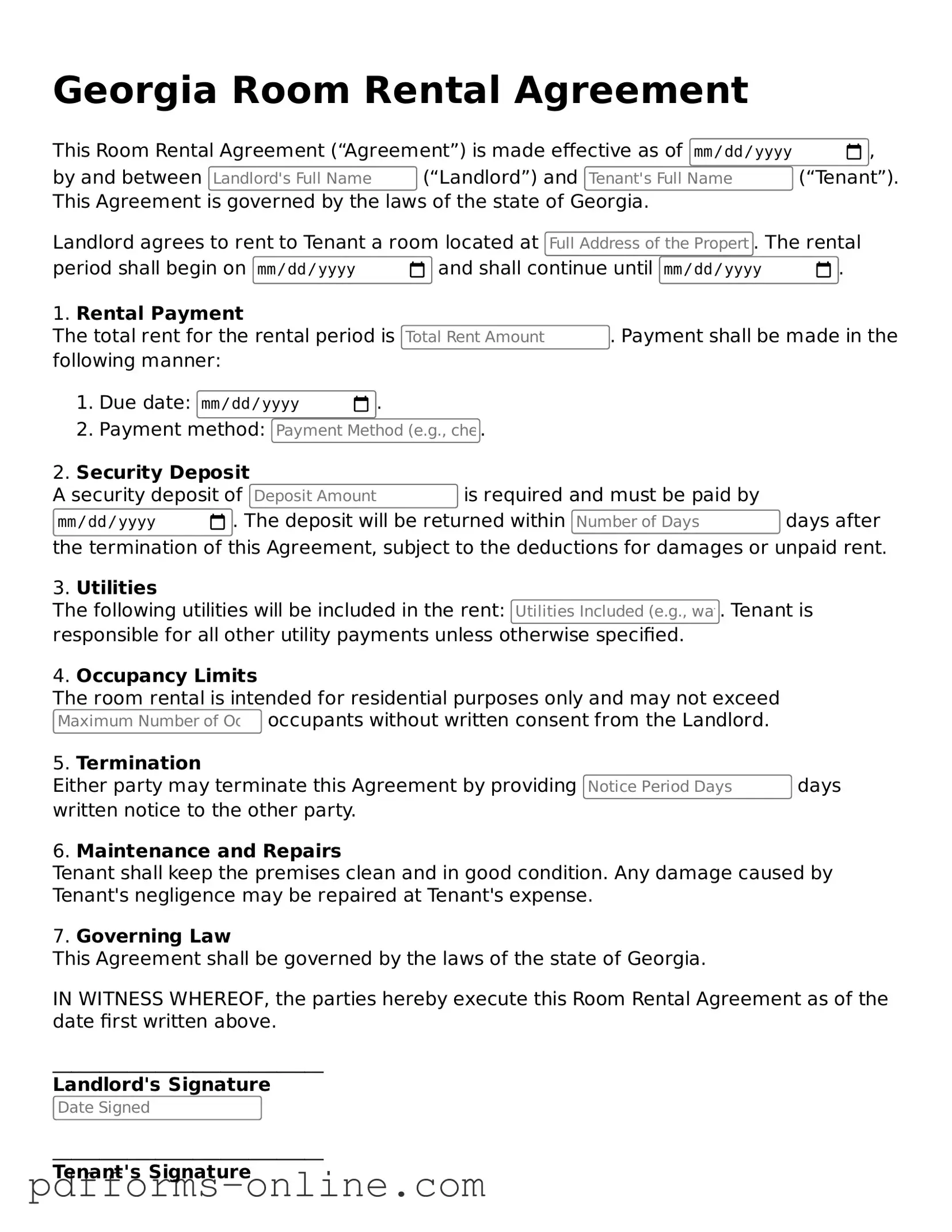The Georgia Room Rental Agreement form shares similarities with the standard Lease Agreement. Both documents outline the terms and conditions under which a tenant can occupy a property. They specify the rental amount, payment due dates, and the duration of the tenancy. Additionally, both agreements often include clauses regarding security deposits, maintenance responsibilities, and the process for terminating the agreement. While the Lease Agreement typically covers longer-term rentals, the Room Rental Agreement may focus on shorter stays, yet both serve to protect the rights of landlords and tenants alike.
Another document that resembles the Georgia Room Rental Agreement is the Sublease Agreement. This form allows a tenant to rent out a portion of their leased space to another individual. Like the Room Rental Agreement, it details the rental terms, including the rent amount and duration. It also requires the original tenant to obtain permission from the landlord, ensuring that all parties are informed and agree to the arrangement. Both documents aim to clarify the responsibilities of each party and provide a clear understanding of the living situation.
The Rental Application form is another document that parallels the Room Rental Agreement. While the Rental Application is typically completed before a lease is signed, it serves a similar purpose in establishing the terms of occupancy. This application collects essential information about potential tenants, such as their employment history and creditworthiness. Once approved, the details from the application can inform the conditions laid out in the Room Rental Agreement, ensuring that the landlord has a clear picture of who will be residing in the property.
Moving on, the Roommate Agreement is closely related to the Georgia Room Rental Agreement. This document is often used when multiple individuals share a rental space, outlining each roommate's responsibilities, including rent payment and maintenance duties. Similar to the Room Rental Agreement, it seeks to prevent misunderstandings by clearly defining the expectations of each roommate. Both agreements help foster a harmonious living environment by addressing potential conflicts before they arise.
The Eviction Notice also shares common ground with the Room Rental Agreement. While the former is a legal document that informs a tenant of their eviction, it often references the terms set out in the Room Rental Agreement. Both documents are rooted in the same legal framework, and the eviction notice may cite specific violations of the rental agreement, such as failure to pay rent or breach of lease terms. This connection emphasizes the importance of adhering to the established rules and conditions outlined in the Room Rental Agreement.
For individuals looking to protect sensitive information during business dealings or partnerships, a Non-disclosure Agreement form is essential. This legal contract clearly delineates the confidential material and allows parties to share information securely while maintaining restrictions against third-party access. Resources such as OnlineLawDocs.com provide templates and guidance for drafting effective NDAs, ensuring that all parties are adequately protected in their professional interactions.
The Move-In Checklist is another document that complements the Room Rental Agreement. This checklist is typically used when a tenant first occupies a rental space. It details the condition of the property and any existing damages, ensuring that both the landlord and tenant have a mutual understanding of the state of the premises. Similar to the Room Rental Agreement, the Move-In Checklist serves to protect both parties by documenting the condition of the property at the start of the tenancy.
The Termination Agreement is also akin to the Room Rental Agreement, as it outlines the process for ending a rental arrangement. This document specifies the notice period required and any conditions that must be met before the agreement can be terminated. Both agreements emphasize the importance of communication and clarity in the rental relationship, ensuring that both the landlord and tenant understand their rights and responsibilities when it comes to ending the tenancy.
Finally, the Security Deposit Agreement is similar to the Georgia Room Rental Agreement in that it addresses the financial aspects of renting a space. This document outlines the amount of the security deposit, the conditions under which it may be withheld, and the timeline for its return. Both agreements work together to protect the landlord's property and provide assurance to the tenant that their funds will be handled appropriately. Together, they create a comprehensive framework for the rental relationship.
